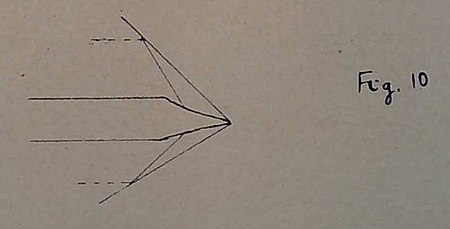three shocks. On the other hand, for angles of incidence which are only slightly greater than the inclination of the vortex sheet to the horizontal is only very slight: accordingly under these circumstances the three shock solutions may be expected to represent on a first approximation the situations actually realized in the Mach effect.
In contrast to the relatively simple case presented by the strong shocks the weak shocks present a case which is more difficult to interpret. Thus considering the case of a relatively weak shock we find that for incident shocks of intensity we have the sequence of three shock configurations depicted in Fig. 9. Here the stationary Mach reflection occurs for an angle of incidence . The corresponding angle of reflection is . In other words the solution to the problem of regular reflection to which the present stationary Mach solution corresponds is the "unstable" one. So that from one point of view we may suppose that the stationary Mach reflection realized in this manner may not in fact occur in practice. On the other hand if we formally continue the three shock solutions beyond the angle we are led to configurations of shocks which are in striking agreement with what have sometimes been observed in the photographs of shocks issuing from a bullet of the type shown in Fig. 10.

Fig. 10
On the strength of this evidence we are tempted to conclude that when two shocks (at least one of which is of weak intensity) intersect at a relatively small angle we would in fact be led to configurations of shocks and vortex sheet of the kind shown in Fig. 7 (see particularly the cases for and ). We may therefore even expect that the stationary







